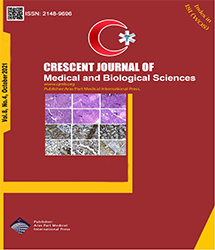| Original Article | |
| Bloodstream Infections in the South of Iran: Microbiological Profile and Antibiotic-Resistance Patterns of Isolated Bacteria | |
| Mojtaba Anvarinejad1, Masoomeh Khalifeh2, Jalal Mardaneh3, Gholamreza Pouladfar1, Mohammad Ali Dehyadegari1 | |
| 1Professor Alborzi Clinical Microbiology Research Center, Nemazee Hospital, Shiraz University of Medical Sciences, Shiraz, Iran 2Department of Medical Biotechnology, Faculty of Medicine, Mashhad University of Medical Sciences, Mashhad, Iran 3Department of Microbiology, School of Medicine, Infectious Diseases Research Center, Gonabad University of Medical Sciences, Gonabad, Iran |
|
|
CJMB 2021; 8: 312-318 Viewed : 4460 times Downloaded : 3032 times. Keywords : Bloodstream, Bacterial infections, Drug resistance, Microbial resistance |
|
| Full Text(PDF) | Related Articles | |
| Abstract | |
Objectives: Bloodstream infection (BSI) causes significant morbidity and mortality in patients, especially in developing countries. Changes in the epidemiological pattern of microorganisms, as well as the growth of antibacterial resistance have become important health concerns in Iran. The aims of this study were to evaluate the spectrum of pathogens causing BSIs in hospitalized patients in Shiraz, Iran, and their corresponding antimicrobial resistance patterns. Materials and Methods: In this retrospective study, 1585 positive blood samples were analyzed from March 2013 to March 2014. Samples from all hospitals within Shiraz were transferred to Professor Alborzi Clinical Microbiology Center. Then, the isolates were identified according to standard methods such as the analytical profile index system, and antibiotic susceptibility patterns were established consistent with the recommendations of the Clinical and Laboratory Standards Institute. Results: Coagulase-negative staphylococci (39%), Staphylococcus aureus (15.3%), Escherichia coli (8.5%), Pseudomonas spp. (7.5%), Enterococcus spp. (7.3%), and Acinetobacter spp. (6.6%) were the most frequent bacteria isolated from blood cultures. Linezolid and vancomycin (VA) had the highest effectiveness against gram-positive bacteria and gram-negative bacteria had high sensitivity to polymyxin B and colistin. Totally, 56.2% of Enterococcus isolates were VA-resistant (VRE) and 55.2% (122) of S. aureus were methicillin-resistant (MRSA). Finally, 59.02% (72) of E. coli isolates, 33.3% (5) of Serratia spp., and 42.85% (33) of Klebsiella spp. were extended-spectrum β-lactamase (ESBL) positive. Conclusions: Considering the results, the emergence of resistant strains such as MRSA, VRE, and ESBL is an alarming threat that would be a severe clinical issue with critical restrictions on antibiotic therapy. |
Cite By, Google Scholar
Google Scholar
PubMed
Online Submission System
 CJMB ENDNOTE ® Style
CJMB ENDNOTE ® Style
 Tutorials
Tutorials
 Publication Charge
Medical and Biological Research Center
About Journal
Publication Charge
Medical and Biological Research Center
About Journal
Aras Part Medical International Press Editor-in-Chief
Arash Khaki
Deputy Editor
Zafer Akan


















